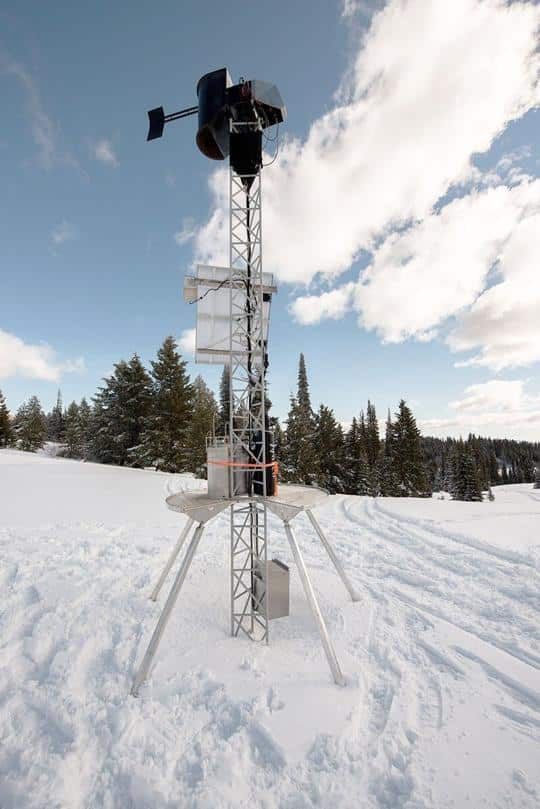This article was published on: 02/10/23 3:48 PM
The thick, dark clouds that have poured over the Cascades from Western Oregon in winter have provided only mediocre amounts of snowfall in recent years.
Now, some hope cloud seeding could turn things around and boost snowpack in times of drought.
Oregon Sen. Lynn Findley, R-Vale, last month submitted a bill that could open up opportunities for cloud seeding in Oregon.
Siera Watson, chief of staff for Findley, said the bill has been referred to the Natural Resources Committee, but a meeting has yet to be been scheduled.
The science behind cloud seeding involves introducing tiny ice nuclei into certain types of subfreezing clouds. The nuclei provide a base for snowflakes to form around them. It’s basically giving Mother Nature a helping hand.
There are two main methods of seeding clouds: one uses dry ice (carbon dioxide) and the other uses silver iodide. Dry ice is not toxic, and silver iodide is a salt that has not been found to be harmful to humans or the environment in the small amounts used in cloud seeding operations.
Industrial emissions of silver iodide into the atmosphere are usually far larger than the amount released during cloud seeding, said Larry O’Neill, an associate professor at Oregon State University’s College of Earth, Ocean, and Atmospheric Science.
“Ecological and human health impact studies have not found any adverse impacts in regions subjected to cloud seeding,” said O’Neill. “As far as is known, cloud seeding appears to be safe.”
Oregon has some history of cloud seeding. Portland General Electric attempted to artificially produce precipitation in the mid-1970s as a way to increase runoff to help generate hydroelectric power but abandoned the program after one winter.
“It ended that program in part because their estimates showed only a possible 10% increase in snowpack, which was not statistically significant, and because of concerns that seeding operations changed the intensity of snowfall that made roads more dangerous,” said O’Neill.
Southern Oregon had a cloud-seeding operation in the 1950s that was aimed at reducing summer hail storms, which damaged orchards. That operation also ended after protests from local crop producers who claimed that cloud seeding somehow prevented rainfall, O’Neill said.
Modern-day cloud seeding is becoming more widely accepted and is widely used in neighboring Idaho. The Idaho Collaborative Seeding Program says it creates 1.2 million acre-feet of water annually from its operations. The $4 million project operates 57 remote ground generators and three aircraft. The estimated cost of the water is $3.22 per acre-foot.
But O’Neill remains skeptical about how much cloud seeding would impact water availability in Oregon.
“Many studies dispute whether cloud seeding has any measurable impact on precipitation,” said O’Neill. “It is safe to say that even if cloud seeding does enhance precipitation, it is by an amount that would have little influence on the water supply here.”
O’Neill adds that the programs can still divide communities. Some say seeding clouds can create dangerous amounts of rainfall. There are also concerns that it can inhibit rain that might fall elsewhere. “There will always be controversy surrounding any weather modification attempt, which may not be worth the possible small benefits,” said O’Neill.
Deschutes County Commissioner Phil Chang said he is open to exploring the option of cloud seeding, but he said Central Oregon should first focus its attention on improving the efficiency of agricultural water use, including canal piping.
“There are tens of thousands of acre-feet of water available in the basin through irrigation modernization if we are willing to do the work and invest the resources,” Chang said in an email. “I’d like to see us focusing on supply reliability strategies with certain outcomes.”
Authorities caution that a cloud seeding-program can take time to develop. Mike Britton, executive manager of North Unit Irrigation District, says it will take three to five years to start “assuming investigations warrant the effort.”
“It could be a potential opportunity to create more water for the state, but it’s way down the road, if at all,” said Britton.
Still, Britton thinks a study is warranted. He has heard skeptics dismiss the science but four years into a drought that is ravaging farming communities he says any option should be on the table.
“When I started talking about cloud seeding people thought I was crazy — smoke and mirrors stuff,” said Britton. “But we’d be remiss given our current state of water supply statewide if we didn’t at least investigate it.”
-Michael Kohn




